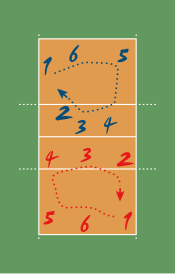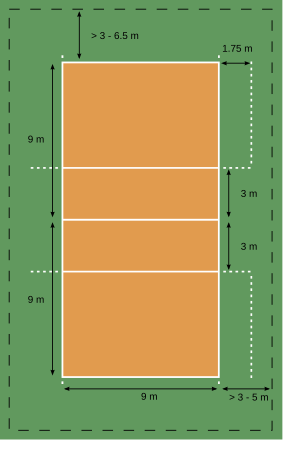|
Tamil Nadu - Sports - Volleyball
Typical volleyball action |
|
| |
|
| Highest governing body |
FIVB |
| First played |
1895, Holyoke, Massachusetts, United States |
| |
|
Characteristics
|
|
| Contact |
No Contact |
| Team members |
6 |
| Mixed gender |
Single |
Categorization
Equipment
Olympic |
Indoor
Volleyball
1964 |
Origin of volleyball
On February 9, 1895, in Holyoke, Massachusetts USA, William G Morgan, a YMCA physical education director, created a new game called Mintonette as a pastime to be played preferably indoors and by any number of players. The game took some of its characteristics from tennis and handball. Another indoor sport, basketball, was catching on in the area, having been invented just ten miles sixteen kilometers away in the city of Springfield, Massachusetts, only four years before. Mintonette was designed to be an indoor sport less rough than basketball for older members of the YMCA, while still requiring a bit of athletic effort.
The first rules, written down by William G Morgan, called for a net 6 ft 6 in (1.98 m) high, a 25×50 ft 7.6×15.2 m court, and any number of players. A match was composed of nine innings with three serves for each team in each inning, and no limit to the number of ball contacts for each team before sending the ball to the opponents’ court. In case of a serving error, a second try was allowed. Hitting the ball into the net was considered a foul (with loss of the point or a side-out) except in the case of the first-try serve.
After an observer, Alfred Halstead, noticed the volleying nature of the game at its first exhibition match in 1896, played at the International YMCA Training School now called Springfield College, the game quickly became known as volleyball it was originally spelled as two words: "volley ball . Volleyball rules were slightly modified by the International YMCA Training School and the game spread around the country to various YMCAs.
The court
The game is played on a volleyball court 18 meters long and 9 meters 29.5 feet wide, divided into two 9 m × 9 m halves by a one-meter (40-inch) wide net placed so that the top of the net is 2.43 meters 7 feet 11 5/8 inches) above the center of the court for men's competition, and 2.24 meters for women's competition (these heights are varied for veterans and junior competitions .
There is a line 3 meters from and parallel to the net in each team court which is considered the "attack line". This "3 meter" (or 10 foot) line divides the court into "back row" and "front row" areas (also back court and front court). These are in turn divided into 3 areas each: these are numbered as follows, starting from area "1", which is the position of the serving player:

Volley Court

After a team gains the serve (also known as siding out), its members must rotate in a clockwise direction, with the player previously in area "2" moving to area "1" and so on, with the player from area "1" moving to area "6".
The team courts are surrounded by an area called the free zone which is a minimum of 3 meters wide and which the players may enter and play within after the service of the ball. All lines denoting the boundaries of the team court and the attack zone are drawn or painted within the dimensions of the area and are therefore a part of the court or zone. If a ball comes in contact with the line, the ball is considered to be "in". An antenna is placed on each side of the net perpendicular to the sideline and is a vertical extension of the side boundary of the court. A ball passing over the net must pass completely between the antennae (or their theoretical extensions to the ceiling) without contacting them.
The ball
FIVB regulations state that the ball must be spherical, made of leather or synthetic leather, have a circumference of 65–67 cm, a weight of 260–280 g and an inside pressure of 0.30–0.325 kg/cm2. Other governing bodies have similar regulations.
|